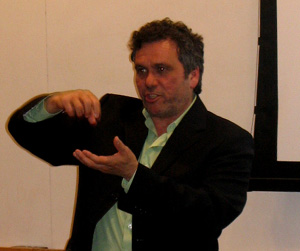- About MAA
- Membership
- MAA Publications
- Periodicals
- Blogs
- MAA Book Series
- MAA Press (an imprint of the AMS)
- MAA Notes
- MAA Reviews
- Mathematical Communication
- Information for Libraries
- Author Resources
- Advertise with MAA
- Meetings
- Competitions
- Programs
- Communities
- MAA Sections
- SIGMAA
- MAA Connect
- Students
- MAA Awards
- Awards Booklets
- Writing Awards
- Teaching Awards
- Service Awards
- Research Awards
- Lecture Awards
- Putnam Competition Individual and Team Winners
- D. E. Shaw Group AMC 8 Awards & Certificates
- Maryam Mirzakhani AMC 10 A Awards & Certificates
- Two Sigma AMC 10 B Awards & Certificates
- Jane Street AMC 12 A Awards & Certificates
- Akamai AMC 12 B Awards & Certificates
- High School Teachers
- News
You are here
Edward Belbruno on Low-Energy Pathways in Space, Chaos, and Random Walks
 Early in the history of the solar system, the theory goes, an object the size of Mars collided with Earth, and the massive, glancing impact produced the ejected material that formed into the Moon. But where did this object come from?
Early in the history of the solar system, the theory goes, an object the size of Mars collided with Earth, and the massive, glancing impact produced the ejected material that formed into the Moon. But where did this object come from?
In his recent presentation at the MAA's Carriage House Conference Center, mathematician Edward Belbruno explained how he and Princeton colleague J. Richard Gott III developed a plausible answer to that question. In what Belbruno described as a "math talk with engineering in it," he ranged from chaotic dynamics and celestial mechanics to cataclysmic collisions, random walks, and space travel.
The proposed explanation hinges on the existence of stable orbits associated with points (Lagrange points L4 and L5) where, in effect, the combined gravitational pulls of the Sun and Earth precisely cancel the acceleration an orbiting object would need to move with them, creating a gravitational well. Belbruno and Gott posit that debris could have accreted into a massive object at one of these Lagrange points. Eventually, gravitational interactions with other objects would have kicked it into a chaotic, creeping orbit, in which the object would have a reasonably high probability of striking Earth.
Belbruno described the mathematical machinery required to establish the plausibility of such a scenario, delving into celestial mechanics and the three-body problem, chaotic dynamics, application of the Kolmogorov-Arnold-Moser Theorem, and random walks. He showed that, in the three-body problem, random impulses, analogous to the discrete steps of a random walk, would jog an object into horseshoe oscillations, with an eventual transition to breakout motion.
Similar ideas, concerning weak stability boundaries, had proved useful several years earlier, when Belbruno uncovered a new type of low-energy route to the Moon, where capture by the Moon is automatic. In 1991, the novel route resurrected a Japanese lunar mission and enabled the spacecraft Hiten to reach the Moon in three months with almost no fuel. "It saved the spacecraft, and it saved my career," Belbruno remarked.
NASA is now preparing a mission to the moon that will also use the same low-energy trajectory to save fuel. Belbruno provides much background material on these low-energy pathways in space in his books Fly Me to the Moon: An Insider's Guide to the New Science of Space Travel (Princeton University Press, 2007) and Capture Dynamics and Chaotic Motions in Celestial Mechanics: With Applications to the Construction of Low Energy Transfers (Princeton University Press, 2004).
In the meantime, NASA's twin STEREO probes will be testing Belbruno and Gott's lunar hypothesis by looking for the remains of the object that may have once orbited the Sun near Earth before it crashed into Earth and spawned the moon.
Belbruno concluded his talk by showing images of some of his oil paintings, many of which have space-related themes.
id:
4281
News Date:
Wednesday, April 29, 2009




